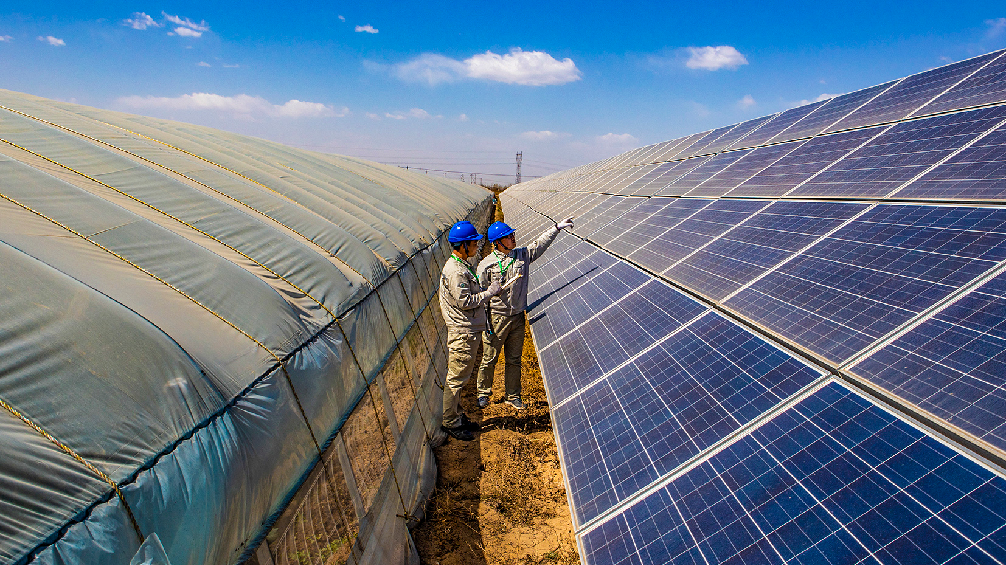
Checking the condition of photovoltaic (PV) solar panels at a PV station in Wuyi County, north China's Hebei Province, March 30, 2019. /Xinhua
Checking the condition of photovoltaic (PV) solar panels at a PV station in Wuyi County, north China's Hebei Province, March 30, 2019. /Xinhua
Editor's note: Alexander Ayertey Odonkor is an economic consultant, chartered financial analyst and chartered economist with an in-depth understanding of the economic landscape of countries in Asia and Africa. The article reflects the author's opinions and not necessarily the views of CGTN.
The considerable increase in the use of renewable energy in China's energy mix in recent years is a development that is generating global interest. As the country that accounts for one-fifth of the world's entire energy consumption, China is the world's largest energy consumer. Although China's current level of energy consumption is comparatively high, the country is expected to record an upswing in energy consumption in the future. Projections made by the International Renewable Energy Agency (IRENA) suggest that by 2030, China's energy consumption will soar by 60 percent – an outcome that could worsen the pernicious impact of climate change.
As a country that is fully committed to mitigating climate change, China is implementing policies that are directing investments towards the development of renewable energy sources which are addressing the challenges associated with energy security. For instance, in 2013, China's installed solar photovoltaic capacity exceeded that of the entire output of all European countries.
With a goal to curb climate change and increase the proportion of renewable energy in the global energy mix, China has become a major exporter of renewable energy technology, as the country accounts for about two-thirds of the world's production of solar photovoltaic equipment. In addition to this remarkable feat, China installed the world's largest capacity of hydroelectric power, wind and biogas. With an effective waste-to-energy management system, China's waste-to-energy capacity is currently second to none.
Highlights of a report from the International Energy Agency indicate that in 2017, 399 plants in China generated 7.3 gigawatts of power, mainly from waste incineration. Between 2010 and 2016, the country's energy from waste (EfW) capacity increased by an average of 1 gigawatt per year. This growth represented the largest share of bioenergy and about 40 percent of China's total production. For the five-year period (2010 to 2016), China's bioenergy capacity grew at an annual average growth rate of 26 percent, which exceeded the four percent growth recorded in OECD countries for the same duration. All these impressive achievements highlight China's commitment to developing renewable energy to aid in the fight against climate change.

A Nio eT Preview electric sedan on display at the 18th Shanghai International Automobile Industry Exhibition in Shanghai, China, April 16, 2019. /Xinhua
A Nio eT Preview electric sedan on display at the 18th Shanghai International Automobile Industry Exhibition in Shanghai, China, April 16, 2019. /Xinhua
Another area that unveils a country's level of commitment in adopting renewable energy is investment in research. In 2019, the Global Commission on the Geopolitics of Energy Transformation published a report that revealed that at the end of 2016, China was ahead of the rest of the world in research and development for renewable energy with more than 150,000 renewable energy patents, which represented 29 percent of the global total.
For major oil exporters such as Indonesia, Russia and Saudi Arabia, the share of renewable energy patents for these countries was negligible. As China continues to augment the capacity of renewable energy within its borders, the country is gradually reducing the reliance on fuel imports and the risk associated with energy price shocks which could impede economic growth.
By positioning itself as the global leader and the largest exporter of clean energy, China is now spearheading efforts to increase the number of electric vehicles in its domestic market. This is part of an attempt to attenuate carbon emissions in the country.
From 2009, China has carried out policy reforms to encourage its citizens to purchase plug-in electric vehicles. By 2030, China expects electric vehicles to account for 40 percent of all vehicle sales in the country. This directive will boost the production of electric vehicles and their batteries, considering the fact that China is home to the world's largest automobile market.
The revolution of renewable energy bolsters China's global leadership on climate change especially as the influence of fossil fuel exporters is declining. During the 75th session of the United Nations General Assembly, President Xi Jinping disclosed that China expects to experience a peak in carbon emission by 2030 and also achieve carbon neutrality before 2060. This is a goal the country intends to achieve via the implementation of vigorous policies and measures.
In his speech, the president encouraged other countries to also take advantage of the renewable energy revolution and set up sustainable growth patterns that could enhance a green recovery of the global economy in the post-COVID-19 era.
In the history of the international community's fight against climate change, China earned a significant role by achieving clean energy targets, introducing a policy shift towards a new low-carbon development model and setting the pace for technological advancement in renewable energy. It is important to note that the fight against climate change is not the sole responsibility of major powers like China. It is incumbent on every sovereign country to implement climate policies that are innovative and effective in lowering greenhouse gas emissions.
(If you want to contribute and have specific expertise, please contact us at opinions@cgtn.com.)

